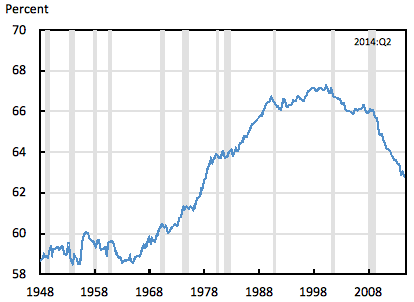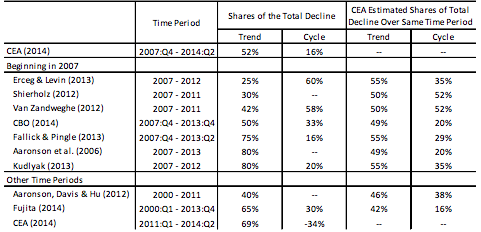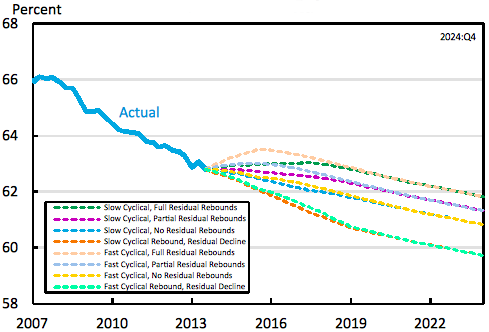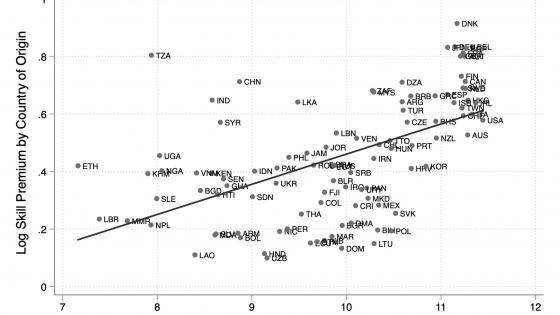In part due to the vigorous, multi-front response to the economic crisis, the US has enjoyed a sustained economic recovery that has exceeded most contemporaneous and historical financial crisis benchmarks. Up until a year ago, the unemployment rate was falling by an average of 0.7 percentage points per year, roughly tracking the more successful historical experiences, and well exceeding the norm following a financial crisis. In the past year, the pace of the decline in the unemployment rate has doubled. As a result, the official unemployment rate is 83% of the way back to its pre-Global Crisis average. A variety of other indicators -- such as broader measures of labour market underutilisation that include discouraged workers or marginally attached workers as well as unemployment rates for different demographic groups -- show similar magnitudes of recovery.
But even as the overall economy has recovered, the participation rate has continued to trend down. However, the decline in the participation rate was at least in part predictable and was, in fact, predicted; while 2008 is better known for the global financial crisis, it was also the beginning of a US retirement boom as the first baby boomers (born in 1946) turned age 62 and became eligible for Social Security benefits. This decline, however, was amplified by the recession.
Background on the participation rate
From 1962 to 1999, a surge of women into the workforce accounted for a nearly 8 percentage point increase in the participation rate, as is shown in Figure 1. This growth plateaued in the late 1990s, and since the fourth quarter of 2007, the participation rate has dropped sharply by 3.0 percentage points. Ascertaining the reasons for this drop is difficult because changes in labour force participation reflect not just the evolving age distribution of the population but also other structural factors that impact people’s decisions to participate in the labour force, such as current economic conditions, changing choices about schooling, and changes in the health of older workers.
Figure 1. Total civilian labour force participation rate
Source: Bureau of Labour Statistics.
There is a substantial body of literature that examines the decline in the labour force participation rate, including the effect of the ageing population (see, for example, Aaronson et al. 2006, Erceg and Levin 2013, CBO 2014, Fallick & Pingle 2013, Kudlyak 2013). In CEA (2014), we extend that literature by using a combination of cross-sectional data and time series techniques to decompose the decline in the participation rate since 2007Q4 into contributions of:
- The ageing trend;
- We estimate that approximately half the decline (1.7 percentage points) is due to the fact that the population is ageing;
- Normal cyclical fluctuations;
- Approximately one-sixth (0.5 percentage points) is due to common cyclical factors experienced in every recession;
- Special factors unique to the Great Recession.
Approximately one-third (0.9 percentage points) appears to be due to other factors, which may be either specific to the long recovery from the Great Recession or due to other non-ageing related trends.
These estimates are generally within the range of comparable estimates from the literature, as shown in Table 1.
Table 1. Comparison of participation rate estimates
Source: Various Sources; CEA calculations.
Note: This table only includes direct estimates of the trend and cyclical components. CEA-equivalent decompositions for time periods listed on an annual basis are computed from Q4 to Q4 of the corresponding years.
Explaining the decline in the participation rate since 2007
In CEA (2014), we attempt to disentangle some of the drivers behind the decline in participation through direct estimation of ageing trends and standard cyclical factors, using both cross-sectional and time series analysis. Specifically, we estimate three components of the decline in the participation rate:
- A pure ageing effect;
- A standard cyclical effect, and
- A residual which picks up a combination of pre-existing trends that are unrelated to ageing and factors unique to the Great Recession.
Ageing and the workforce
The largest single factor behind the decline is the ageing of the population. In order to understand how an ageing population affects overall labour force participation, it is helpful to look at the participation rates of different age groups. Figures 2 and 3 show the participation rate profiles for men and women over the course of their lives for various birth cohorts. For both men and women, participation rises throughout the 20s as individuals leave full-time schooling and enter the workforce, flattens out during prime working-age years, and then falls to low levels again as individuals enter their 60s and go into retirement.
Source (both Figures 2 and 3): Bureau of Labour Statistics; CEA calculations.
This very large drop-off in participation at older ages implies that, all else equal, the ageing US population will reduce the economy-wide participation rate. To estimate the impact of ageing, ignoring other changes in the labour market and economy, we hold constant the age-participation profile in 2007 and weigh it alternatively with age weights as of 2007Q4 and 2014Q2; the change in the participation rate is an estimate of the ageing effect on participation. The resulting estimated ageing effect is a decline of 1.7 percentage points, which is roughly half the decline in the participation rate since 2007Q4.
Standard business cycle effects
When the economy is booming, the labour force participation rate rises and often exceeds the predicted long-term trend, and during downturns the participation rate falls below trend, as nonparticipants become less likely to enter the labour force and the unemployed (who always exhibit a higher tendency to exit the labour force) become more numerous relative to the employed (Elsby et al. 2013). Figure 4 below shows this cyclicality in the participation rate by comparing it with the unemployment gap, defined as the difference between the actual unemployment rate and the natural unemployment rate, where both series are detrended using a low-frequency (biweight) time series filter. Although this time series trend estimation does not explicitly use any information about the age distribution of the population, the estimated trend contribution over the 2007Q4-present period turns out to be the same as the ageing trend estimated above -- 1.7 percentage points.
Figure 4. Detrended participation rate and (inverted) unemployment gap
Source: Bureau of Labour Statistics; CEA calculations.
As is described in more detail in CEA (2014), we estimate the cyclical component by projecting the detrended labour over all participation rate on current and past values of the detrended unemployment gap, specified in first differences using a parsimonious lag specification involving the four-quarter difference of the unemployment gap. We estimate that between 2007Q4 and the present, business cycle effects alone explain 0.5 percentage points (about one sixth) of the total fall in the participation rate.
Other effects on participation: Non-ageing trends and factors unique to the Great Recession
Most of the decline in participation since the end of 2007 is accounted for by the ageing of the population and standard cyclical effects. The remaining reduction in the participation rate—about 0.9 percentage point since the end of 2007—remains unexplained. As can be seen in Figure 5, this residual has emerged during the past two years as the unemployment rate has recovered.
Figure 5. Labour force participation decomposition
Source: Bureau of Labour Statistics; CEA calculations.
There are several potential explanations for this residual. Participation rates conditional on age were declining for many groups in the run-up to 2008, including a long-running decline in participation among prime-age men that has been occurring since at least the 1950s, and a much smaller decline among prime-age women since the late 1990s. In addition, older workers have recently begun to increase their participation rates at a given age. These or other trends may be exerting greater force on the participation rate than our model predicts, potentially because they are compounded with a trend break that leads the statistical estimates of the ageing plus non-ageing trend to be underestimated. Aaronson et al. (2006) predicted that non-ageing related trends, together with ageing trends, would lower the participation rate to 62.9% in 2014, precisely its current value—lending plausibility to the view that cohort effects unrelated to ageing are partly responsible for the residual.
But the fact that this residual only emerged in recent years also suggests that much of it may be due to cyclical factors specific to the Great Recession and its aftermath. We therefore examined three unique factors of the Great Recession that may explain this: schooling, disability insurance, and long-term unemployment. More specifically, variables representing these three factors – the school enrolment rate, the Social Security disability insurance claimant rate, and the mean duration of unemployment (all detrended)—were included separately as explanatory variables in the time series regressions of the participation rate in addition to the current and lagged unemployment rate. These series are themselves cyclical, but because these specifications include the unemployment rate, including them examines the extent to which divergences of these series from normal cyclical patterns can potentially explain the participation residual.
Of these three candidate explanations for the residual, the only one that is quantitatively large and statistically significant is the mean duration of spells of unemployment. In a mechanical sense the mean duration, which is now unusually long this late into an expansion, explains much of the previous residual, as seen in Figure 6. While this time series analysis is only suggestive, it is consistent with a large body of work that points to the corrosive effect of long-term unemployment on the ability of workers to find work and reintegrate into the labour market.
Figure 6. Labour force participation decomposition including mean duration of unemployment
Source: Bureau of Labour Statistics; CEA calculations.
The outlook for the participation rate
This analysis suggests that over the next few years the participation rate could rise or fall slightly, followed by a resumption of its longer-term decline due to the continued ageing of the population. The residual component of the decline in participation represents the greatest source of uncertainty about the participation rate going forward, due to the obscurity of its causes, in particular whether it reflects non-ageing trends or the effects of the Great Recession. Figure 7 shows several scenarios for the participation rate, with a common assumption about the ageing trend but varying assumptions about the evolution of the cyclical and residual components discussed above. While these scenarios are not projections and do not represent the full range of possibilities, they do indicate that the participation rate is likely to be roughly stable in the near term but will decrease more rapidly after the economy returns to full employment and the ageing effects once again dominate.
Figure 7. Alternative scenarios for the participation rate
Source: Bureau of Labour Statistics; Social Security Administration; CEA calculations.
Conclusion and some policy implications
Maximising the labour force participation rate itself is not a goal of public policy—for example, younger people may choose to be in school, middle-age parents may choose to care for their children, or older people may choose to retire. But in many cases, existing distortions, market failures, or circumstances result in sub-optimal decisions around participation. Moreover, given the role of the participation rate in the level and potentially even the growth rate of national output, it has broader ramifications for fiscal sustainability, the rate of return of pay-as-you-go systems, and the economy as a whole.
A number of policies would have the benefit, or even the goal, of raising the labour force participation rate. The most significant of these is immigration reform, which the Congressional Budget Office (CBO) estimates would increase the labour force by 6 million workers by 2023 and raise the participation rate by 0.7 percentage points. But policies targeting specific demographics can also have a sizeable impact. After increasing strongly starting in the 1960s, since 2000 female labour force participation has generally been flat or declining. A number of barriers and distortions suppress female labour force participation, including the lack of paid leave, workplace flexibility, and continued discrimination on pay. Finally, building labour force attachment among the young can raise their participation profile throughout life.
References
Aaronson, D, J Davis, and L Hu (2012), “Explaining the Decline in the U.S. Labor Force Participation Rate.” Chicago Fed Letter 296.
Aaronson, S, B Fallick, A Figura, J Pingle, and W Wascher (2006), “The Recent Decline in the Labor Force Participation Rate and Its Implications for Potential Labor Supply.” Brookings Papers on Economic Activity Spring 2006: 69-154.
(CBO) Congressional Budget Office (2014), “The Slow Recovery of the Labor Market” Congressional Budget Office. February.
(CEA) Council of Economic Advisers (2014), “The Labor Force Participation Rate Since 2007: Causes and Policy Implications.”
Elsby, M, B Hobijn, and A Sahin (2013), “On the Importance of the Participation Margin for Labor Market Fluctuations.” Unpublished manuscript.
Erceg, C J, and A T Levin (2013), “Labor Force Participation and Monetary Policy in the Wake of the Great Recession.” Federal Reserve Bank of Boston, April 2013.
Fallick, B and J Pingle (2013), “A Cohort-Based Model of Labor Force Participation.” September, 2013.
Fujita, S (2014), “On the Causes of Declines in the Labor Force Participation Rate.” Federal Reserve Bank of Philadelphia. February 6, 2014.
Kudlyak, M (2013), “A Cohort Model of Labor Force Participation.” Economic Quarterly 99(1): 25-43. First Quarter 2013.
Shierholz, H (2012), “Labor Force Participation: Cyclical versus Structural Changes since the Start of the Great Recession.” Economic Policy Institute. Issue Brief #333. May 24, 2012.
Van Zandweghe, W (2012),“Interpreting the Recent Decline in Labor Force Participation,” Federal Reserve Bank of Kansas City Economic Review, First Quarter 2012, 5-34.














